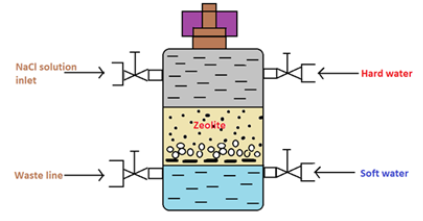

 Titration reaction: HY3–(aq) + Ca2+(aq) CaY2–(aq) + H+ (aq) (also for Mg2+) End point reaction: HY3–(aq) + MgIn– (aq) MgY2–(aq) + HIn2–(aq) As the indicator requires a trace of Mg2+ to operate properly, a little magnesium ion will be added to each solution. The effect of the added Mg2+ can be subtracted by titrating a blank. A simple way to calculate the hardness in water.A sample of hard water contains 1mg cacl2 and 1 mg mgcl2 per
Titration reaction: HY3–(aq) + Ca2+(aq) CaY2–(aq) + H+ (aq) (also for Mg2+) End point reaction: HY3–(aq) + MgIn– (aq) MgY2–(aq) + HIn2–(aq) As the indicator requires a trace of Mg2+ to operate properly, a little magnesium ion will be added to each solution. The effect of the added Mg2+ can be subtracted by titrating a blank. A simple way to calculate the hardness in water.A sample of hard water contains 1mg cacl2 and 1 mg mgcl2 per litre . calculate the hardness of water in terms of caco3 present in per 106 parts of water. Hardness of water in terms of Caco3= (molar mass of hardness causing substance*molecular weight of Caco3)/ (molecular weight of hardness causing substance. Thus, cacl2 hardness = 1mg*100/111 = 0.900ppm for Mgcl2 Hardness = 1mg*100/95=1.052ppm Total hardness of water in terms of Caco3 = 0.90+1.052= 1.952ppm
|
|
Ca (HCO3)2+CaO⟶2CaCO3+H2O Since 5.6 mg5.6 mg of lime is required, amount of calcium bicarbonate present is 16.2×10−316.2×10−3. Molarity = 16.2×10−3/ (162×5) =0.002 M=0.002 M. This is equivalent to the concentration of calcium carbonate. ppm of calcium carbonate = 0.002×10−2×100×106×10−3=2000.002×10−2×100×106×10−3=200 Therefore, degree of hardness is 200 ppm |
2. Wet or Electrochemical theory of Corrosion: This corrosion occurs in metals that come in direct contact with a conducting liquid of two different metals are dissolved in a solution partly. There is formation of galvanic cell on the metal, as part of the metal acts as an anode and the rest is the cathode, the chemical in the solution along with the humidity acts as the electrolyte. Oxidation takes place in such conditions resulting in corrosion at the anode surface and reduction occurs at the cathode surface of the metal. In this case corrosion occurs at the anode but rust gets deposited on the cathode.
Q7) Define waterline corrosion?A7) This is a kind of corrosion that involves an oxidation process to materials that come in contact with water. Waterline corrosion occurs when one portion of the material is exposed to air and the other portion is immersed in water. Therefore, a corrosion reaction occurs as there is a differential amount of oxygen in contact with the material's surface above and below the waterline and results in a corrosive reaction.This mainly occurs when there is a difference in the oxygen concentration between the water and the atmosphere. The material that is more exposed to air forms the cathode and the portion that is less exposed to oxygen (the portion dipped in water) forms the anode. The presence of anode and cathode allows an oxidation reaction to occur. This ultimately causes the area of the substrate submersed in water to become oxidized and corrode Q8) Explain the concept of sacrificial anode?A8) It is a method where an easily eroded material is deliberately placed in a tank or a pipe to be sacrificed for corrosion and the rest of the system remains free from corrosion.A sacrificial anode is also known as a galvanic anodeThe mechanism that occurs in this process is very similar to that of an electrochemical system. In this technique the metal that is protected is placed on the cathode side and then a more reactive metal or alloy (having a larger potential difference than the protected metal) is chosen and connected to the protected metal as an anode. The redox reaction will proceed spontaneously. As the reaction proceeds the sacrificial metal gets consumed as oxidation reaction occurs at the anode, simultaneously reduction reaction occurs on the cathode, thus preventing the metal from erosion. Thus, corrosion on the protected metal is successfully shifted to the anode, protecting the metal.Sacrificial anodes are normally supplied with either lead wires or cast-m straps to facilitate their connection to the structure being protected. The lead wires may be attached to the structure by welding or mechanical connThe materials used for sacrificial anodes are either relatively pure active metals, such as zinc or magnesium, or are magnesium or aluminium alloys that have been specifically developed for use as sacrificial anodes.Advantages of using sacrificial anodes: